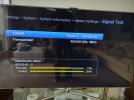Trev
The Dumb One
I know. That's why I said 'we' reather than we.I'm not, that's for sure.
Re transponder. Being from an air traffic/air defence radar background, Of course I 100% agree with you, but for some obscure reason a 're-transmitting multiplex' from a TV satellite is called a 'transponder'. I suspect that this has been derived from early communication sats, but quite why, I don't know.



